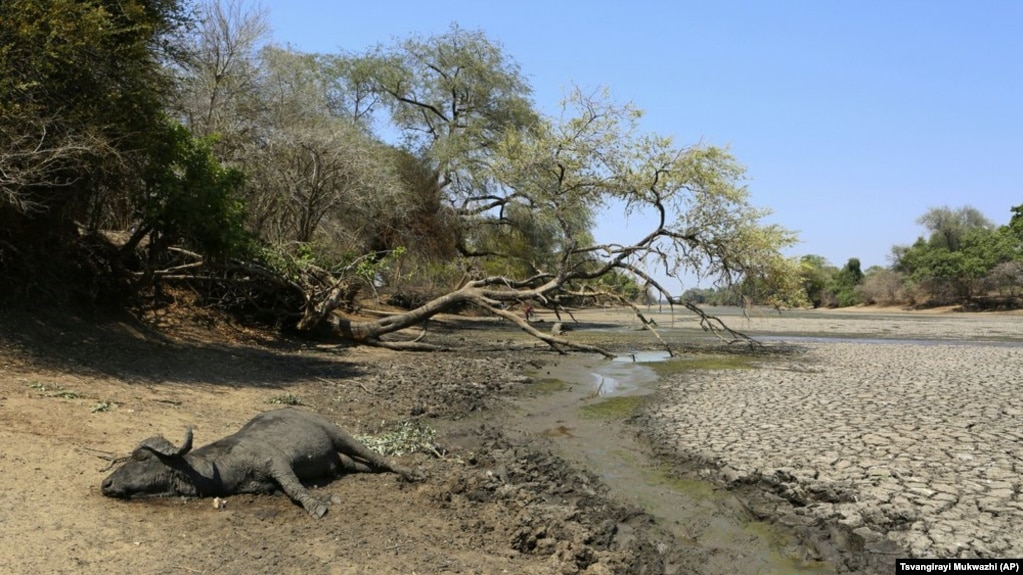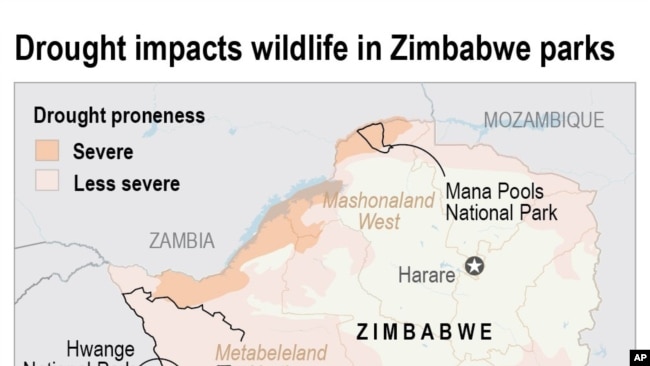Zimbabwe’s Mana Pools National Park has not received rain in months, and animals like elephants and water buffalo are dying.
Source: Severely Dry Weather Is Killing Zimbabwe’s Wildlife – VOA

The 2,196- square-kilometer wildlife reserve gets its name from the four nearby bodies of water that the flooding Zambezi River fills every rainy season. The area is home to elephants, zebras, hippopotamuses and many other kinds of wildlife.
Many animals are moving out of the parks and into nearby communities in search of food and water.
Mana Pools is a United Nations Educational, Scientific and Cultural Organization World Heritage Site known for its beauty. The area experiences hot, dry weather at this time every year. But this year, the dry conditions have been much worse. Even the river’s flow has reduced.
Hopes for rain
Each morning, Munyaradzi Dzoro, a parks agency wildlife officer, hopes for rain.
The last major rainfall came in April, he said.

Mel Hood works with the Feed Mana project, which is providing food support to animals in the area. She said an early end to a “very poor rainy season” has limited the growth of plants the animals need.
The area’s once dependable water resources have turned dangerous for the animals. Many have gotten stuck in the soft soil or clay while trying to reach Long Pool, a five-kilometer-long watering hole. It is one of the few remaining water resources in the park but is only five percent of its normal size.
There are more than 12,000 elephants in Mana’s flood plains. Lions, buffaloes, zebras, wild dogs, hyenas, 350 kinds of birds and many water animals live in the park, the parks agency reports.
“We used to say nature should take its course,” Dzoro said of the park’s normal policy of not getting involved and letting the ecosystem find its own balance.
Now, he said, officials are getting involved to avoid losing animals and maintain population sizes.
Local plant life such as acacias, as well as other trees and grasses, provide most of the food for big animals like elephants and buffaloes. But the lack of rain has severely reduced the amount of plant life, so officials began bringing food to the park in July.
Mel Hood says The Feed Mana project has been asking for “urgent” donations of animal feed such as soy bean hay and grass.
“Although it may not be enough to stave off all the hunger…it is certainly giving these animals a chance to survive until conditions improve,” Hood said.
I’m Pete Musto.
Farai Mutsaka reported this story for the Associated Press. Pete Musto adapted it for VOA Learning English. Mario Ritter Jr. was the editor. We want to hear from you. How do officials protect endangered animals in your country? Write to us in the Comments Section or on our Facebook page.
